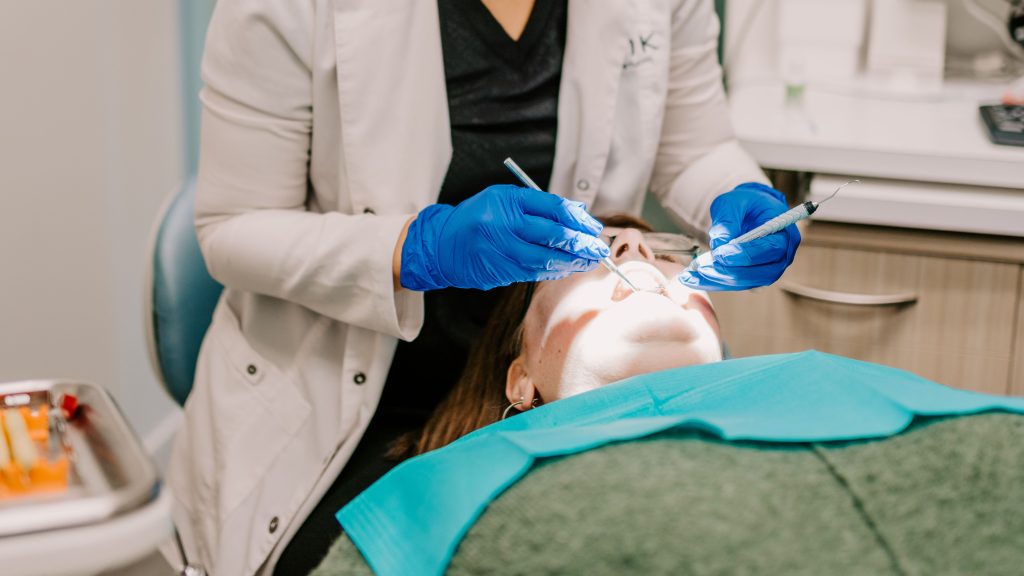
Preventive dental services are essential to maintaining good oral health. Regular checkups help you avoid serious and costly dental problems. At a routine visit, we will ask you to update us on your general health information, we’ll do a thorough cleaning of your teeth and gums, and a full assessment of your mouth to screen for any potential issues. But there’s a lot more to it than that. Here are 10 things you may not know our team was doing at your regular cleanings and exams.
- Screening for oral cancer.
They will be looking for red or white patches or mouth sores inside the mouth, as well as examining the throat and neck for any lumps.
- Taking gum measurements and periodontal charting.
To determine your gum health, your dental hygienist will use a probe to gently press into the pocket of space between a tooth and the gum tissue it’s anchored to. The size of this space indicates how healthy the gum tissue is. They will also check for gum recession or bleeding gums. Read more about gum care between dental appointments: Gingivitis, Oral Hygiene and Gum Health.
- Milking your salivary glands.
This will be a gloved finger under your tongue with gentle pressure applied to stimulate the salivary glands and ensure that they are not blocked/clogged and saliva is flowing as it should be. Our saliva helps to clean and protect our teeth as well as maintain the pH level in our mouths so it’s an important piece of the oral health puzzle.
- Assessing the condition of old dental work.
If you have any old fillings or other repair work that’s been done in your mouth, your dentist will check them to ensure they are still in good condition. Most old fillings can begin to deteriorate and will require replacement or repair eventually.
- Looking for signs of grinding or enamel damage.
Many people grind their teeth without being aware they are doing it, so the dentist will always check the condition of the enamel along the molars and where the teeth meet in your bite. Consistent grinding can wear away the enamel and jeopardize your teeth. For more on this, read TMD and Your Teeth: Tips and Treatments to Protect Your Enamel.
- Evaluating your bite and TMJ.
Your jaw position can dictate how your teeth rest and where they meet eachother when you bite. Your dentist can determine the weakest points in your bite and recommend preventive measures to protect those points in your mouth and prevent serious dental issues such as cracks or cavities due to excessive wear. Many people with misaligned bites, also called malocclusion (overbite under bite) will be more likely to snore or have sleep apnea, both of which can be addressed by your dentist.
- Using an ultrasonic scaler in addition to manual scale removal tools.
An ultrasonic scaler has a tiny vibrating tip that creates small, rapid shock waves that disturb biofilm and blast tartar calculus so that it becomes easier to remove. When used in conjunction with a small jet of water, the ultrasound and vibration of the scaler breaks the water into millions of tiny bubbles that help knock off tartar deposits and flush away debris loosened by the vibrating action of the ultrasonic scaler. They can also clean beneath the gum line. The process is very gentle and completely painless. The hygienist will then use a manual scaling tool to scrape anything missed by the ultrasonic scaler.
- Applying fluoride varnish with a small brush.
You might have thought it was a nail polish brush, but this little brush of the same size is used to apply a layer of fluoride varnish which is quick and easy—a huge improvement from the trays of foam we used to use. The varnish can be left to rest on your teeth for the rest of the day until it naturally flakes off. If you don’t like the feeling of it, you can brush your teeth after 2-3 hours of wearing it.
- Thoroughly inspecting each tooth visually and via x-ray.
We routinely take bitewing X-rays at every yearly check up or any other X-ray that is deemed necessary. Bitewing radiographs help us visualize posterior teeth and bone levels only. At a new patient visit we will take a ‘full mouth series’ which involves X-rays of all of the teeth including anterior X-rays, bitewings, and also a panoramic radiograph which helps us visualize both jaws. Both bitewings and panoramic X-ray would be updated every 5 years unless they are needed sooner for a specific reason.
- Looking at your tonsils and tongue.
your dentist will check the size and texture of the tongue to ensure a healthy mouth. Your tongue’s size and surface can determine a lot about your dental health, as well as your overall health.
Visit our Saskatoon clinic for the best prevention of oral health problems.
The team of dental professionals at BLOK Dental Studio recommends that you see your dentist every 6 months so that we can stay on top of any changes in your oral health as they happen. It may not seem like much, but your dentist and oral hygienist are doing more than you realize during each visit to ensure that you can maintain a healthy, confident, and beautiful smile. Give us a call today to schedule your next cleaning and exam!
